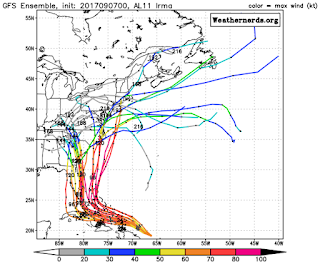 Major Hurricane Irma has just been upgraded back to a Category 5 storm with maximum sustained winds of 160 mph. It has been throwing forecasters for a loop as we try to figure out what it is going to do and where it is going to go. Well, now that we are closer to the event, models are able to represent the storm more closely to what will actually happen, and they are doing so with much more confidence and consistency allowing forecasters to zone in on the target zone.
Major Hurricane Irma has just been upgraded back to a Category 5 storm with maximum sustained winds of 160 mph. It has been throwing forecasters for a loop as we try to figure out what it is going to do and where it is going to go. Well, now that we are closer to the event, models are able to represent the storm more closely to what will actually happen, and they are doing so with much more confidence and consistency allowing forecasters to zone in on the target zone.Track Shift
Irma was always going to hook to the north; that was a fairly confident forecast for meteorologists. The issue arose with when and how sharp of a turn. At this point, the hope for Florida is that Irma has direct interaction with Cuba, that meaning the eye of Irma drifts over land so that friction with the surface as well as a change in wind shear can weaken this monster storm. If Irma does make landfall on Cuba, then Florida might see a category 3 or 4 version of the storm. However, if Irma continues on its westnorthwestward path, missing Cuba altogether (although effects from winds and rain will still affect Cuba and are affecting Cuba now), then with the fuel from the extremely warm (almost 90F!) waters south of Florida.

Where is Irma going?
As the cone suggests, our best forecast is that Irma will ride straight up the Florida peninsula, making its own stop at Disney World while the parks are closed down for 2 d
ays, and continue up through Atlanta, GA and into Tennessee. This is the best forecast we have for now with Hurricane Irma.
How Strong will it be?
Irma will be making landfall in south Florida as a Major Hurricane, meaning Category 3 or stronger. The main threat is if Irma does not make landfall over Cuba and continues to strengthen as a Category 5 prior to impact with the Florida Keys.
If Category 5
If Irma makes landfall as a Category 5 Hurricane, then it will remain a major hurricane likely until crossing into Georgia before being downgraded to a Category 2. South and Central GA will experience hurricane force winds (winds >74 mph) and South Carolina and North Carolina will experience tropical storm force winds (winds >35 mph). Then, Irma will be weakened to the point of a depression prior to entering Tennessee. Keep in mind... these are maximum sustained winds discussed here.
Gusts are a different story: Gusts in Florida could still reach 200+ mph... it would be devastating to all structures and vehicles in its way. Georgia could experience gusts exceeding 130 mph, SC gusts > 75 mph, and eastern and central NC gusts higher than 50 mph (while western NC like Asheville could see gusts exceed 70 mph). Tennessee will still likely see a breezy rain storm with gusts possibly exceeding 40 mph.
If Category 3/4
If Irma makes landfall as a Category 3, however, after interacting with the land and terrain of Cuba, then it could weaken enough to be categorized as a tropical storm prior to the central pressure exiting Florida. If this happened, then Georgia, the Carolinas, and Tennessee would receive little more than a windy rain storm.
***Currently (11:00 EST Friday, 09/08/2017) Irma is making a westward shift into Cuba, potentially bringing to fruition the Category 3 and preferred case for the United States***
What will happen along the coast?
 East Coast
East CoastThe east coast of Florida, GA, SC, and south NC will still receive wind, rain, and some storm surge from the power of the winds, however flooding will not be nearly as bad from the ocean itself. There is still a possibility of flooding from rain flowing downstream post-event, but surge will not swallow the coastline like what happened in Sandy or Harvey.
West Coast
The west coast of Florida, however, will receive more significant surge. While the strongest quarter of the storm, typically the Northeast quadrant of the storm, will not be shoving the Atlantic inland trying to gain real estate east of I-95, the southwest quadrant of Irma will still have an effect on the west coast as Irma moves further north. Cape Coral, Sarasota, and Tampa will likely all receive more significant storm surge now that the westward shift is being realized.
To the right I have posted an image from the RadarScope (copyright) application with the Miami, Florida radar image. At 9:58 CDT the outer rain bands were quite visible on the Miami radar.
Stay tuned to your local meteorologists for the most up-to-date information. The same key messages apply, and it is recommended that coastal Floridians evacuate, and take your pets with you. DO NOT LEAVE YOUR PETS BEHIND. It is very sad to hear about pets, let alone human beings, being left behind in storms such as these. They are helpless, and after some of the things I saw in the Harvey aftermath, people can be cruel beings. Please take ALL of your FAMILY MEMBERS with you. They love you unconditionally, and we can all learn a thing or two from that kind of love the Lord commands. Be safe all, and God bless.





